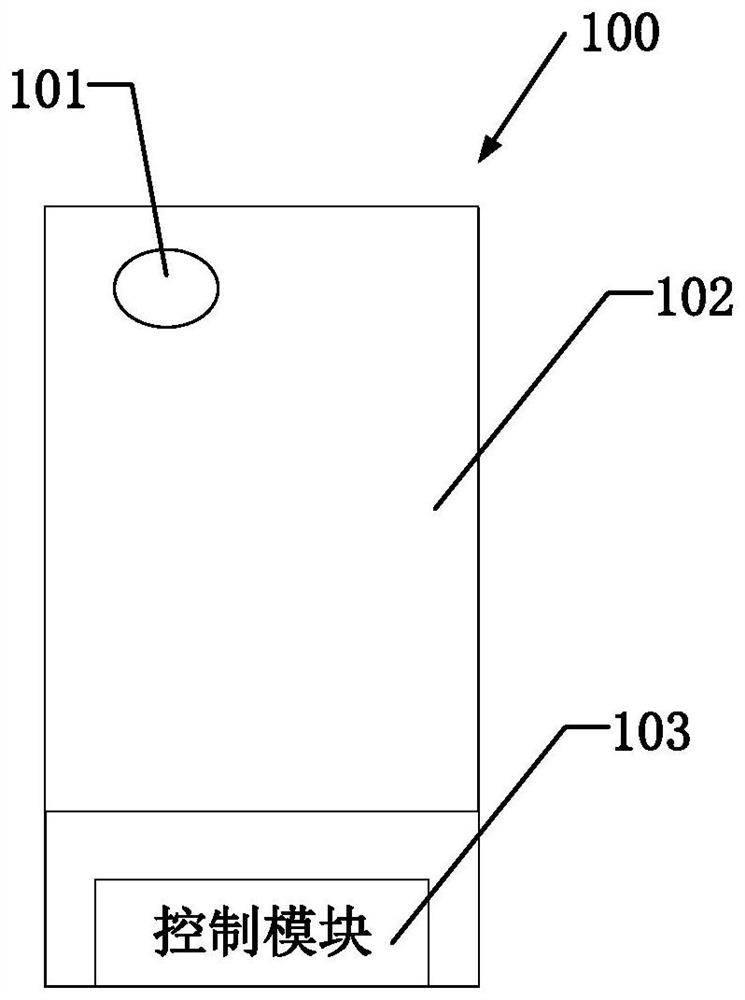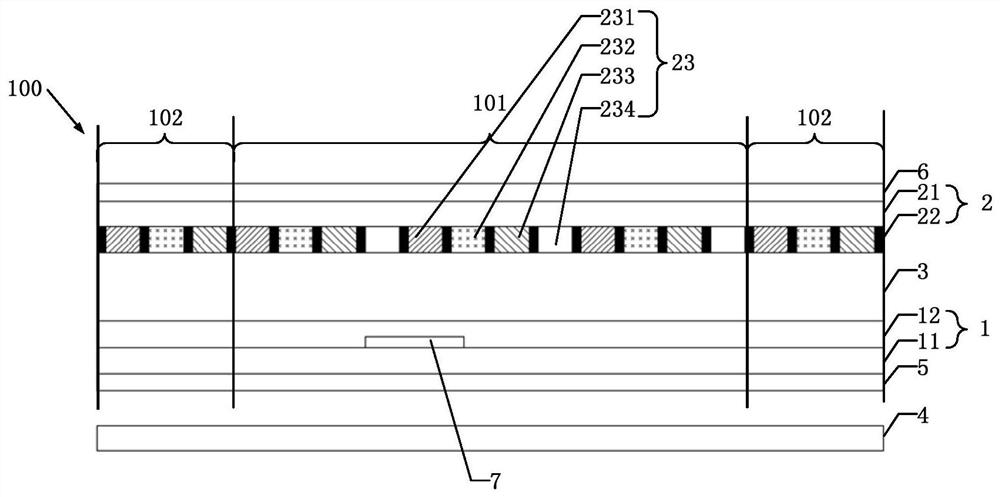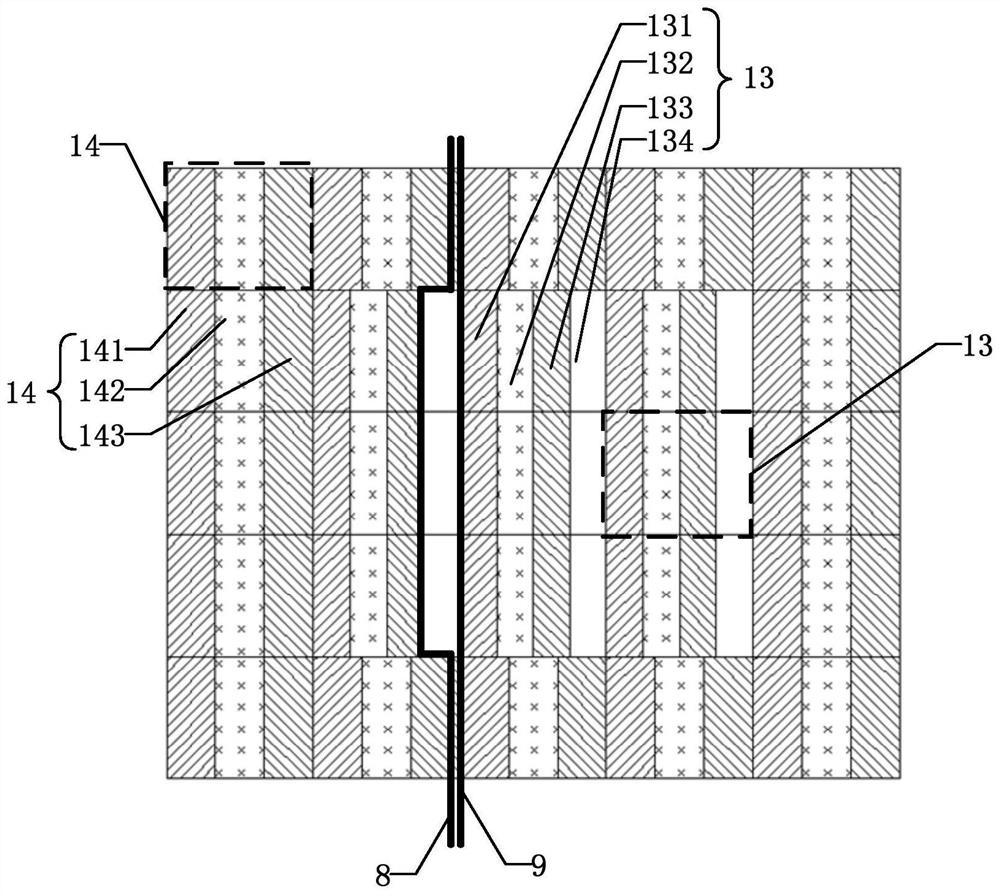A display panel and its driving method
A display panel and driving method technology, applied in static indicators, instruments, nonlinear optics, etc., to achieve the effects of improving work performance, increasing light transmittance, and saving production costs
- Summary
- Abstract
- Description
- Claims
- Application Information
AI Technical Summary
Problems solved by technology
Method used
Image
Examples
Embodiment 1
[0049] like figure 1 As shown, this embodiment provides a display panel 100 , which defines a sensing display area 101 and a conventional display area 102 surrounding the sensing display area 101 .
[0050] like figure 2 As shown, the display panel 100 includes an array substrate 1 and a color filter substrate 2 that are disposed opposite to each other.
[0051] like figure 2 As shown, the array substrate 1 includes: a first substrate 11 and an array layer 12 . The color filter substrate 2 includes: a second substrate 21 and a color filter layer 22 .
[0052] The first substrate 11 and the second substrate 21 are disposed opposite to each other. Both the first substrate 11 and the second substrate 21 can be flexible substrates, which have the function of blocking water and oxygen, and both the first substrate 11 and the second substrate 21 have good impact resistance, which can effectively protect the display panel 100 . The materials of the first substrate 11 and the ...
Embodiment 2
[0069] like Image 6 As shown, Embodiment 2 includes most of the technical features of Embodiment 1, and the difference between Embodiment 2 and Embodiment 1 is that the white sub-pixels 134 of at least two first pixel units 13 are disposed adjacent to each other. In this embodiment, arranging the white sub-pixels 134 adjacent to each other can increase the amount of light reaching the sensing device 7 in this part, which facilitates the rapid operation of the sensing device 7, speeds up the recognition speed of the fingerprint recognition sensor in the sensing device 7, and improves the transmission speed. The photographing effect of the camera in the sensing device 7 is displayed.
Embodiment 3
[0071] like Figure 7 As shown, Embodiment 3 includes most of the technical features of Embodiment 1. The difference between Embodiment 3 and Embodiment 1 is that the first pixel unit 13 of Embodiment 3 further includes: a first red sub-pixel 131, a A green sub-pixel 132, a first blue sub-pixel 133, and three white sub-pixels 134; the three white sub-pixels 134 are respectively disposed at the end of the first red sub-pixel 131, the third The end of a green sub-pixel 132 and the end of the first blue sub-pixel 133 . The first signal line 8 and the second signal line 9 are both gate lines. The first signal line 8 connects the control module 103 and the white sub-pixels 134 in the first pixel unit 13 ; the second signal line 9 connects the control module 103 and the first pixel unit 13 (in this embodiment, the second signal line 9 controls the first red sub-pixel 131, the first green sub-pixel 132 and the first blue sub-pixel 133).
PUM
 Login to View More
Login to View More Abstract
Description
Claims
Application Information
 Login to View More
Login to View More - R&D
- Intellectual Property
- Life Sciences
- Materials
- Tech Scout
- Unparalleled Data Quality
- Higher Quality Content
- 60% Fewer Hallucinations
Browse by: Latest US Patents, China's latest patents, Technical Efficacy Thesaurus, Application Domain, Technology Topic, Popular Technical Reports.
© 2025 PatSnap. All rights reserved.Legal|Privacy policy|Modern Slavery Act Transparency Statement|Sitemap|About US| Contact US: help@patsnap.com



